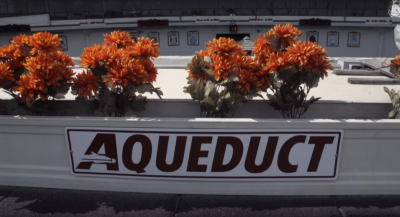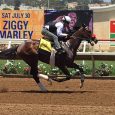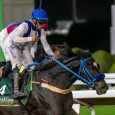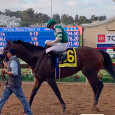 For many horseplayers and handicappers, the approaching winter racing season means Florida and Southern California racing is soon to come, as the best racing of the season migrates away from cold-weather places. However, there’s at least one cold-weather place where racing continues all through the fall and winter. And it’s a place that handicappers should not overlook — Aqueduct.
For many horseplayers and handicappers, the approaching winter racing season means Florida and Southern California racing is soon to come, as the best racing of the season migrates away from cold-weather places. However, there’s at least one cold-weather place where racing continues all through the fall and winter. And it’s a place that handicappers should not overlook — Aqueduct.
Even if you are the type of horseplayer who prefers to play the big winter meets at this time of year, Aqueduct offers excellent betting opportunities for winter-racing horseplayers, particularly on weekends, with big pools and big purses and good racing during the otherwise sparse months of December, January and February. Plus, the November portion of the Aqueduct meet is amongst the best there is in racing for much of the month.
Aqueduct opened on Friday, Nov. 2, and will race on a five-day-per-week schedule through November. Racing at Aqueduct switches to four days a week from December through March. And note that Aqueduct will not be closed for its holiday break, as has been the case in years past.
The 2018-19 Aqueduct winter schedule will all be run on the new winterized main track surface, which was inaugurated last season to good reviews. Therefore, any statistical information older than last season, obviously, is irrelevant, including stats on turf races, because now the turf races are divided into inner- and outer-course affairs, thereby making old turf numbers and trends irrelevant too. What was the inner track is now a second turf course at Aqueduct and, if you like turf racing, you can bet that the Aqueduct turf courses will be used to the fullest throughout November to mid-December. After that, the turf will not be a part of the winter racing product at Aqueduct until the climate permits the grass courses to reopen next April.
Now that fall/winter races at Aqueduct are being run mostly around one turn, no races can be carded at 1 1/16 miles or 1 mile & 70 yards. Almost all Aqueduct winter route races will be one-turn miles, with the exception of some 1 1/8-mile races and a smattering of longer events. In the first three weeks of the 2017-18 Aqueduct meet, a grand total of six two-turn dirt races were contested. Expect those events to remain a virtual non-factor for handicappers this season.
With one full year of racing at the new Aqueduct in already in the books, we have a solid collection of stats to help us handicap through the next six months — and more statistics obviously will be compiled this season. What we’ve learned already is that this Aqueduct main track has proven to be an entirely new surface than the previous Big A main track as well as the old inner track. The old “horses for the course” have been replaced with new ones who prefer the new limestone base to the old clay base on the Big A main track. Races at 6 ½ furlongs and 7-furlong and one-turn miles are now run all winter, and there are no more winter past performances at 1 1/16 miles or 1 mile & 70 yards to mess you up, as you concentrate mostly on one-turn racing just like at the recently concluded Belmont meet.
Aqueduct Track Trends and Prevailing Bias
Just one season into its existence, the new Aqueduct main track mostly has played fairly to all running styles — a far cry from the old Aqueduct inner track which usually favored speed. Now, however, speed horses appear to have no real advantage against pressers, stalkers or closers, based only in their running style. As a matter of fact, if anything, off-the-pace runners might even have a slight edge, because Aqueduct seems to have fewer wire-to-wire winners than the other main tracks on the New York circuit.
Aqueduct’s main track, however, did often show itself to be at the mercy of anti-inside track biases throughout the 2017-2018 meet. Aside from the apparent prevailing daily bias against the inside paths, the track has shown various stronger biases since opening at the start of November 2017. If there is one track trend that handicappers must note on the new Aqueduct main track, it is that paths 1-2 generally have not been the place to be, except for on some bias days when the rail was good. The overall prevailing bias of the Aqueduct main track last season was definitely against inside paths on a day-to-day basis, so you should definitely factor this into your handicapping as the 2018-19 meet begins.
The handicapping angle you can take from this is to look for horses exiting subpar efforts with inside trips in their recent Big A past performances. Horses that lost with inside trips in their last start may be worth upgrading next time out (unless it was one of the inside bias days). In other words, bet back horses exiting inside trips, and bet against horses exiting perfect outside trips last time out.
Interestingly, the slow rail on the Aqueduct main track last season did not really affect post-position statistics, mainly because field sizes were relatively small and horses can usually work out off-the-rail trips even if they draw post one or two. The jockeys all know to stay off the inside for the most part, so the post position statistics mostly have been unaffected.
The outside paths generally enjoy an advantage at Aqueduct and the jockeys often avoid rail trips. Keep a list detailing certain days when the rail and/or inside paths are bad — or, in some cases, when the rail and inside paths were actually good and factor these bias days into your handicapping and you will definitely win more races and pick better-priced winners than the players who ignore this kind of valuable information.
Aqueduct Post Position Trends
The Aqueduct post position trends worth noting for handicappers only go back as far as the 2017-18 season in terms of relevance, because last year was the first year of the new main track racing surface. What horseplayers noticed during the first year on Aqueduct’s new main track was that the inside (and some middle) posts were better in both routes and sprints. According to the statistics, horses drawing posts 1-6 have much better chances to win in sprints than the outside horses. Every Aqueduct sprint post position 1-6 won at between 13 percent and 19 percent in roughly a 200-race sample. Horses breaking from posts 7-12 in sprints won only a combined 6 percent of their starts.
In routes where you’d actually expect to see a bigger inside post bias, there really doesn’t seem to be one at Aqueduct. Posts 1-4 clearly have the better win percentages amongst the route post positions, but there doesn’t seem to be a dramatic drop-off beyond the inside posts the wider you go. This is probably because the biggest portion of Aqueduct routes are one-turn miles and those races favor the inside posts the least and really don’t offer any disadvantage to the outside or middle post draws. The strongest post position angle in routes is in the two-turn route races at 1 1/8 miles or more. In those races, posts 1-4 seem to be especially helpful.
Jockeys and Trainers
Even though there are no longer any Aqueduct main-track and inner-track meets, it’s strange that the meet is divided into different segments — fall, winter, spring — for statistical purposes, but indeed it is. This is due mainly to the fact that the jockey and trainer colonies changes so much over the winter, when many horses and horsemen head to Florida.
Looking back to the fall portion of last year’s Aqueduct meet, which encompassed Nov. 3 to Dec. 31, 2017, we can get a glimpse of what to expect this season, perhaps with some tweaks here and there. The runaway leading rider at this meet last year was Irad Ortiz, who posted 44 wins and a 26 percent win rate (44-for-168). The breakout season last year was enjoyed by Manny Franco, who was the clear second-leading rider with 29 victories from 190 mounts (15 percent). The biggest difference this year is likely to be the impact of Jose Ortiz, who had a bad knee last season and subsequently missed part of the meet for surgery. He was only third-leading rider at this portion of last year’s meet with 22 wins from 117 mounts (19 percent). This season, expect Jose to be right there fighting it out for leading rider, along with brother Irad.
The other leading riders from a win-percentage perspective likely will be John Velazquez (16-for-56, 29 percent last year) and Joel Rosario (13-for-60, 22 percent), both of whom rode sparingly, but did extremely well before they shipped off to Gulfstream.
In terms of number of wins from now until the end of the year, after the Ortiz brothers and Franco, expect the top five to be rounded out by Dylan Davis, who likely will maintain his 13 percent win rate from Belmont at Aqueduct, and perhaps Eric Cancel, who was only a 10 percent rider at this fall portion of last year’s Aqueduct meet, but whose business has since taken off and now seems better than ever, based on his 15 percent win percentage at the recently concluded Belmont meet.
In terms of leading trainers at this portion of the Aqueduct meet, we will quickly begin to see the decline in influence and dominance of the Chad Brown and Todd Pletcher stables and see the rise of local barns whose stock better suits the racing here at this time of the year, led by Rudy Rodriguez and Linda Rice. Both Rodriguez and Rice were 28 percent trainers here last November and December, with Rudy going 27-for-97 and Rice going 26-for-95. Expect similar performances this season to lead all trainers. Chad Brown will continue to win on the grass and Todd Pletcher will continue to unveil his 2-year-olds, but each will fade at Aqueduct, as the next two months unfold and their best stock leaves town for Gulfstream.
Based on the statistics from the November-December portion of the 2017 Aqueduct meet, the other top trainers to focus on will be Michelle Nevin, Bill Mott, H. James Bond and Gary Gullo, who were the fourth-, fifth-, seventh- and eighth-leading trainers at last year’s Big A fall meet. Nevin, Mot, and Bond all racked-up win percentages between 22 percent and 30 percent, and Gullo recorded an amazing 10-for-29 record for 34 percent winners.
Other training specialists to watch will also include Jason Servis, who won 7-for-26 last year (27 percent) and is deadly in turf sprints, Christophe Clement, who took advantage of increased turf racing at the meet to win 8-for-38 starts (21 percent) and Shug McGaughey, who started only 17 horses at last year’s Aqueduct fall meet but won with five of them for 29 percent wins.
Conclusion
Good luck during the Aqueduct winter/spring meet, and enjoy the season. Just because New York racing has shifted to Aqueduct doesn’t mean that there’s not plenty of good racing and wagering still to come the rest of the year. Best of luck.




